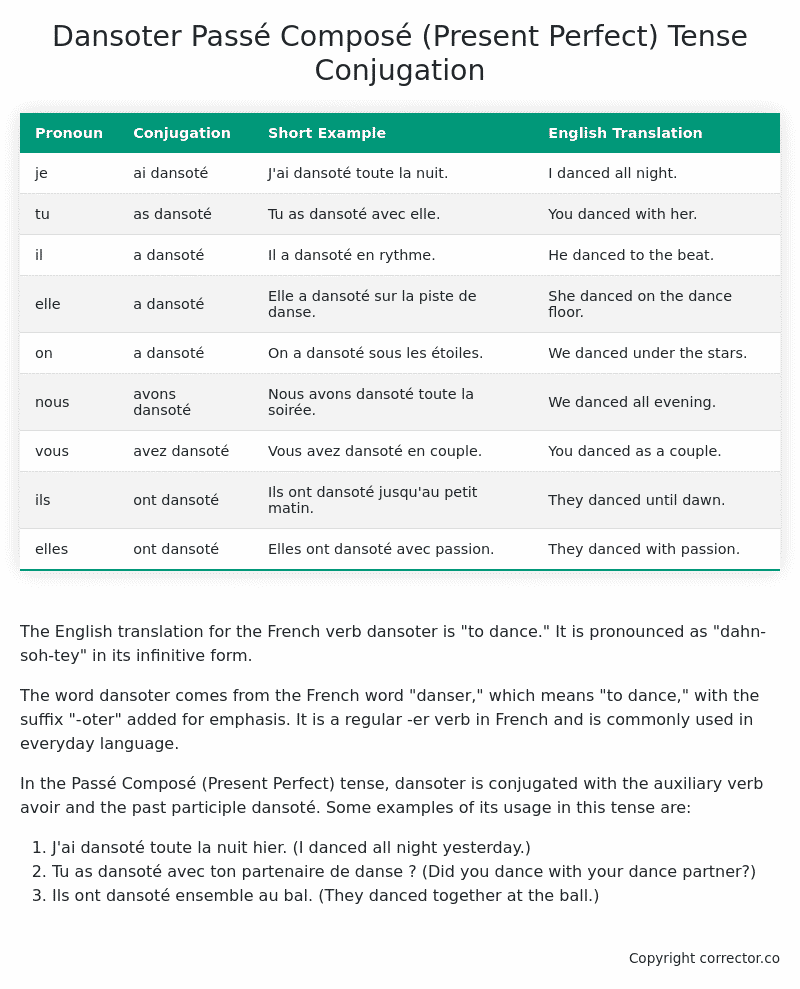Passé Composé (Present Perfect) Tense Conjugation of the French Verb dansoter
Introduction to the verb dansoter
The English translation for the French verb dansoter is “to dance.” It is pronounced as “dahn-soh-tey” in its infinitive form.
The word dansoter comes from the French word “danser,” which means “to dance,” with the suffix “-oter” added for emphasis. It is a regular -er verb in French and is commonly used in everyday language.
In the Passé Composé (Present Perfect) tense, dansoter is conjugated with the auxiliary verb avoir and the past participle dansoté. Some examples of its usage in this tense are:
- J’ai dansoté toute la nuit hier. (I danced all night yesterday.)
- Tu as dansoté avec ton partenaire de danse ? (Did you dance with your dance partner?)
- Ils ont dansoté ensemble au bal. (They danced together at the ball.)
Table of the Passé Composé (Present Perfect) Tense Conjugation of dansoter
| Pronoun | Conjugation | Short Example | English Translation |
|---|---|---|---|
| je | ai dansoté | J’ai dansoté toute la nuit. | I danced all night. |
| tu | as dansoté | Tu as dansoté avec elle. | You danced with her. |
| il | a dansoté | Il a dansoté en rythme. | He danced to the beat. |
| elle | a dansoté | Elle a dansoté sur la piste de danse. | She danced on the dance floor. |
| on | a dansoté | On a dansoté sous les étoiles. | We danced under the stars. |
| nous | avons dansoté | Nous avons dansoté toute la soirée. | We danced all evening. |
| vous | avez dansoté | Vous avez dansoté en couple. | You danced as a couple. |
| ils | ont dansoté | Ils ont dansoté jusqu’au petit matin. | They danced until dawn. |
| elles | ont dansoté | Elles ont dansoté avec passion. | They danced with passion. |
Other Conjugations for Dansoter.
Le Present (Present Tense) Conjugation of the French Verb dansoter
Imparfait (Imperfect) Tense Conjugation of the French Verb dansoter
Passé Simple (Simple Past) Tense Conjugation of the French Verb dansoter
Passé Composé (Present Perfect) Tense Conjugation of the French Verb dansoter (this article)
Futur Simple (Simple Future) Tense Conjugation of the French Verb dansoter
Futur Proche (Near Future) Tense Conjugation of the French Verb dansoter
Plus-que-parfait (Pluperfect) Tense Conjugation of the French Verb dansoter
Passé Antérieur (Past Anterior) Tense Conjugation of the French Verb dansoter
Futur Antérieur (Future Anterior) Tense Conjugation of the French Verb dansoter
Subjonctif Présent (Subjunctive Present) Tense Conjugation of the French Verb dansoter
Subjonctif Passé (Subjunctive Past) Tense Conjugation of the French Verb dansoter
Subjonctif Imparfait (Subjunctive Imperfect) Tense Conjugation of the French Verb dansoter
Subjonctif Plus-que-parfait (Subjunctive Pluperfect) Tense Conjugation of the French Verb dansoter
Conditionnel Présent (Conditional Present) Tense Conjugation of the French Verb dansoter
Conditionnel Passé (Conditional Past) Tense Conjugation of the French Verb dansoter
L’impératif Présent (Imperative Present) Tense Conjugation of the French Verb dansoter
L’infinitif Présent (Infinitive Present) Tense Conjugation of the French Verb dansoter
Struggling with French verbs or the language in general? Why not use our free French Grammar Checker – no registration required!
Get a FREE Download Study Sheet of this Conjugation 🔥
Simply right click the image below, click “save image” and get your free reference for the dansoter present perfect tense conjugation!

Dansoter – About the French Passé Composé (Present Perfect) Tense
Formation of the Passé Composé
Set the auxiliary verb with either
Conjugate the auxiliary verb
Add the past participle
Common everyday usage patterns
Narrating Past Events
Sequential Actions
Describing Completed Actions
Interactions with other tenses
Imperfect Tense
Conditional and Future Tenses
Summary
I hope you enjoyed this article on the verb dansoter. Still in a learning mood? Check out another TOTALLY random French verb conjugation!


